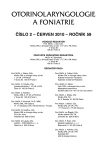Results of Cochlear Implantations in Deaf Blind Children
Authors:
Z. Aksenovová; Z. Kabelka
Authors‘ workplace:
Foniatrické oddělení a rehabilitační centrum kochleárních implantací u dětí
přednosta doc. MUDr. Z. Kabelka
; Klinika ušní, nosní a krční 2. LF UK a FN Motol, Praha
Published in:
Otorinolaryngol Foniatr, 59, 2010, No. 2, pp. 51-54.
Category:
Original Article
Overview
The aim of this study was to identify the benefit of cochlear implantation in deaf blind children. The authors described the post-operative results of 5 prelingual deaf children. They evaluated the level of auditory perception, methods of communication and the ability of speech production. The results show that cochlear implantation can significantly improve the quantity of information from the external world and can help the advance of communication ability and the total development of these handicapped children.
Key words:
cochlear implantation, deaf blindness, prelingual deafness, auditory perception, communication, speech production.
Sources
1. Dammeyer, J.: Congenitally deafblind children and cochlear implants: effects on communication. Journal of Deaf Studies and Deaf Education, 14, 2009, s. 278-288.
2. Dlouhá, O., Černý, L., Hrdličková, M., Jedlička, I., Puchmajer, P., Vohradník, M.: Výsledky preventivního vyšetření sluchu u vysoce rizikových dětí. Otorinolaryngol. a Foniat. (Prague), 51, 2002, č.1, s. 4-7.
3. El-Kashlan, H. K., Boerst, A., Telian, S. A.: Multichannel cochlear implantation in visually impaired patiens. Otology and Neurotology, 22, 2001, s. 53-56.
4. Filipo, R., Bosco, E., Mancini, P., Ballantyne, D.: Cochlear implants in special case: Deafness in the presence of disabilities and/or associated problems. Acta Otolaryngologica (Supplementum), 552, 2004, s. 74-80.
5. Groma, M., Šimková, L., Profant, M., Kabátová, Z., Šimko, Š., Seginko, K.: Vplyv širšieho sociálního prostredia na výkon dieťaťa s kochleárnym implantátom. Otorinolaryngol. a Foniat. (Prague), 52, 2003, č. 3, s. 133-138.
6. Lindsey, C. E.: Children with cochlear implants and complex needs: A review of outcome research and psychological practise. Journal of Deaf Studies and Deaf Education Advance Access, 12, 2007, s. 258-268.
7. Pellant, A., Šram, F., Kalvoda, J., Kabelka, Z.: Současná problematika hluchoslepoty z pohledu otorinolaryngologa. Otorinolaryngol. a Foniat. (Prague), 50, 2001, č. 2, s. 103-105.
8. Saeed, S. R., Ramsden, R. T., Axon, P. R.: Cochlear implantation in the deaf-blind. American Journal of Otology, 19, 1998, s. 774-777.
9. Vymlátilová, E., Příhodová, J., Šupáček, I., Doubnerová, M., Kabelka, Z.: Faktory ovlivňující využití kochleárního implantátu u dětí. Otorinolaryngol. a Foniat. (Prague), 48, 1999, č. 3, s. 131-134.
10. Waltzman, S. B., Scalchunes, V., Cohen, N. L.: Performance of multiply handicapped children using cochlear implants. American Journal of Otology, 21, 2000, s. 329-335.
Labels
Audiology Paediatric ENT ENT (Otorhinolaryngology)Article was published in
Otorhinolaryngology and Phoniatrics

2010 Issue 2
Most read in this issue
- Epiglottitis in Adults
- Relapsing Polychondritis, Manifestations in Otolaryngology Area
- Adenoid Vegetation and Chronic Secretory Otitis
- Validity of HRCT and Surgery Findings in Pathology of Temporal Bone in Children
